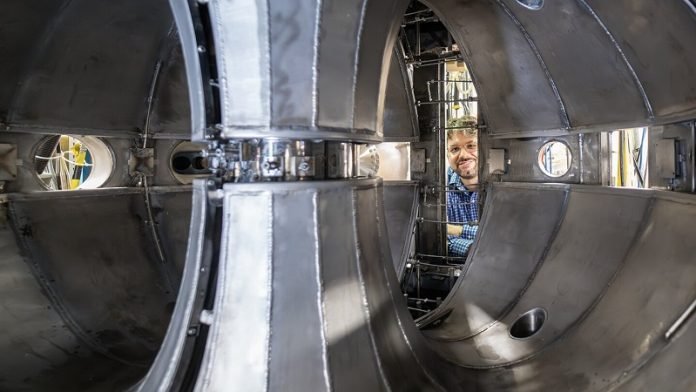
Scientists are exploring new ways to make fusion energy, a clean alternative to fossil fuels, more practical and affordable.
Recent research points to an exciting possibility: using liquid lithium inside fusion devices could make fusion power easier to achieve.
Fusion energy is created by heating plasma, the fourth state of matter, to incredibly high temperatures.
This plasma is a hot gas made of charged particles. At the Department of Energy’s Princeton Plasma Physics Laboratory (PPPL), researchers are focusing on this process using devices called tokamaks.
These devices use magnetic fields to keep the hot plasma in place.
Dennis Boyle, a physicist at PPPL, explains that better confinement of energy in these devices can make them smaller and cheaper.
This would make fusion energy more appealing for investment by governments and industries.
Boyle presented these new findings at a meeting of the American Physical Society Division of Plasma Physics.
The research is part of the Lab’s Lithium Tokamak Experiment-Beta (LTX-β), and is also published in the journal Nuclear Materials and Energy.
The key discovery is that a coating of liquid lithium on the inside walls of the tokamak helps the plasma stay hot at its edge.
Keeping the edge hot is crucial for the success of this fusion approach. Previous experiments with solid lithium coatings showed promise in improving plasma performance. Now, liquid lithium, more suitable for large-scale tokamaks, is showing similar benefits.
Richard Majeski, head of LTX-β at PPPL, points out one of the biggest challenges in fusion energy: building a durable wall for the device that contains the plasma. The liquid lithium not only acts as a strong wall against the 2-million-degree plasma, but it also improves the plasma’s performance.
A photograph by Elle Starkman shows the complex setup of the LTX-β, with Boyle standing in front of the device. Inside LTX-β, a small pool of lithium can be seen, demonstrating the application of liquid lithium.
The benefit of liquid lithium is that it can absorb about 40% of hydrogen ions escaping from the plasma. This reduces the number of these particles that cool down the plasma edge when they return to it. This creates a low-recycling environment, where the edge of the plasma remains as hot as its core. This uniformity in temperature helps the plasma confine heat better, avoiding instabilities.
Additionally, when a beam of high-energy particles was used to heat and fuel the plasma, the presence of liquid lithium allowed for an increase in plasma density. This was different from the results with solid lithium.
The lithium evaporating off the liquid walls and entering the plasma changed how the added hydrogen ions interacted, leading to a higher overall plasma density.
Majeski notes that applying liquid lithium in larger tokamaks will be challenging and expensive. But conducting small-scale experiments like those in LTX-β is crucial for confidently moving towards using liquid lithium in future, larger-scale projects.
This research is not just a scientific achievement; it’s a step towards a future where fusion energy can be a practical, cost-effective, and environmentally friendly power source.



